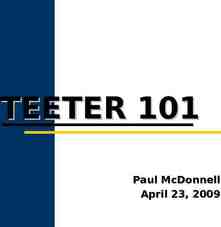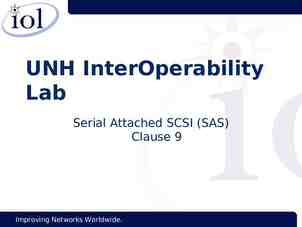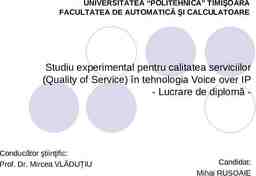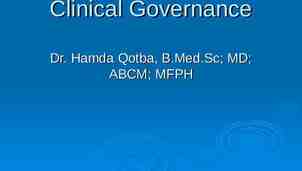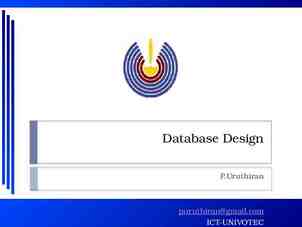Introduction to Information Systems AssignmentPoint assignmentpoint
35 Slides345.50 KB

Introduction to Information Systems www.AssignmentPoint.com www.assignmentpoint.com

Staff Instructors: – Karl Aberer, BC 108, karl aberer at epfl ch – Philippe Cudré-Mauroux, BC 114, philippe cudre-mauroux at epfl ch – Office hours: by appointment TAs: – Gleb Skobeltsyn (exercises) – Martin Rubli (project) www.assignmentpoint.com

Communications Web page: lsirww.epfl.ch – Lectures will be available here – Homeworks and solutions will be posted here – The project description and resources will be here Newsgroup: – epfl.ic.cours.IIS www.assignmentpoint.com

Textbook Main textbook: Databases and Transaction Processing, An application-oriented approach Philip M. Lewis, Arthur Bernstein, Michael Kifer, Addison-Wesley 2002. www.assignmentpoint.com

Other Texts Many classic textbooks (each of them will do it) Database Systems: The Complete Book, Hector Garcia-Molina, Jeffrey Ullman, Jennifer Widom Database Management Systems, Ramakrishnan Fundamentals of Database Systems, Elmasri, Navathe Database Systems, Date (7. edition) Modern Database Management, Hoffer, (4. edition) Database Systems Concepts, Silverschatz, (4. edition) www.assignmentpoint.com

Material on the Web SQL Intro SQL for Web Nerds, by Philip Greenspun, http://philip.greenspun.com/sql/ Java Technology java.sun.com WWW Technology www.w3c.org www.assignmentpoint.com

The Course Goal: Teaching RDBMS (standard) with a strong emphasis on the Web Fortunately others already did it – Alon Halevy, Dan Suciu, Univ. of Washington – http://www.cs.washington.edu/education/ courses/cse444/ – http://www.acm.org/sigmod/record/issues/ 0309/4.AlonLevy.pdf www.assignmentpoint.com

Acknowledgement Build on UoW course – many slides – many exercise – ideas for the project Main difference – less theory – will use real Web data in the project www.assignmentpoint.com

Outline for Today’s Lecture Overview of database systems Course Outline First Steps in SQL www.assignmentpoint.com

What is behind this Web Site? http://immo.search.ch/ Search on a large database Specify search conditions Many users Updates Access through a web interface www.assignmentpoint.com

Database Management Systems Database Management System DBMS A collection of files that store the data A big C program written by someone else that accesses and updates those files for you Relational DBMS RDBMS Data files are structured as relations (tables) www.assignmentpoint.com

Where are RDBMS used ? Backend for traditional “database” applications – EPFL administration Backend for large Websites – Immosearch Backend for Web services – Amazon www.assignmentpoint.com

Example of a Traditional Database Application Suppose we are building a system to store the information about: students courses professors who takes what, who teaches what www.assignmentpoint.com

Can we do it without a DBMS ? Sure we can! Start by storing the data in files: students.txt courses.txt professors.txt Now write C or Java programs to implement specific tasks www.assignmentpoint.com

Doing it without a DBMS. Enroll “Mary Johnson” in “CSE444”: Write a C/Java program to do the following: Read Read ‘students.txt’ ‘students.txt’ Read Read ‘courses.txt’ ‘courses.txt’ Find&update Find&update the the record record “Mary “Mary Johnson” Johnson” Find&update Find&update the the record record “CSE444” “CSE444” Write Write “students.txt” “students.txt” Write Write “courses.txt” “courses.txt” www.assignmentpoint.com

Problems without an DBMS. System crashes: Read ‘students.txt’ Read ‘students.txt’ Read ‘courses.txt’ Read ‘courses.txt’ Find&update Find&updatethe therecord record“Mary “MaryJohnson” Johnson” Find&update the record “CSE444” Find&update the record “CSE444” Write Write“students.txt” “students.txt” Write “courses.txt” Write “courses.txt” CRASH ! – What is the problem ? Large data sets (say 50GB) – Why is this a problem ? Simultaneous access by many users – Lock students.txt – what is the problem ? www.assignmentpoint.com

Enters a DBMS “Two tier system” or “client-server” connection (ODBC, JDBC) Data files Database server (someone else’s Cwww.assignmentpoint.com program) Applications

Functionality of a DBMS The programmer sees SQL, which has two components: Data Definition Language - DDL Data Manipulation Language - DML – query language Behind the scenes the DBMS has: Query engine Query optimizer Storage management Transaction Management (concurrency, recovery) www.assignmentpoint.com

How the Programmer Sees the DBMS Start with DDL to create tables: CREATE CREATETABLE TABLEStudents Students(( Name NameCHAR(30) CHAR(30) SSN SSNCHAR(9) CHAR(9)PRIMARY PRIMARYKEY KEYNOT NOTNULL, NULL, Category CategoryCHAR(20) CHAR(20) )) . . . . Continue with DML to populate tables: INSERT INSERTINTO INTOStudents Students VALUES(‘Charles’, VALUES(‘Charles’,‘123456789’, ‘123456789’,‘undergraduate’) ‘undergraduate’) . . . . www.assignmentpoint.com

How the Programmer Sees the DBMS Tables: Students: SSN 123-45-6789 234-56-7890 Courses: CID CSE444 CSE541 Takes: Name Charles Dan Category undergrad grad Name Databases Operating systems SSN 123-45-6789 123-45-6789 234-56-7890 CID CSE444 CSE444 CSE142 Quarter fall winter Still implemented as files, but behind the scenes can be quite complex “data independence” separate logical view from physical implementation www.assignmentpoint.com

Transactions Enroll “Mary Johnson” in “CSE444”: BEGIN BEGINTRANSACTION; TRANSACTION; INSERT INSERTINTO INTOTakes Takes SELECT SELECTStudents.SSN, Students.SSN,Courses.CID Courses.CID FROM FROMStudents, Students,Courses Courses WHERE WHEREStudents.name Students.name ‘Mary ‘MaryJohnson’ Johnson’and and Courses.name Courses.name ‘CSE444’ ‘CSE444’ ----More Moreupdates updateshere. here. IF IFeverything-went-OK everything-went-OK THEN THENCOMMIT; COMMIT; ELSE ELSEROLLBACK ROLLBACK www.assignmentpoint.com If system crashes, the transaction is still either committed or aborted

Transactions A transaction sequence of statements that either all succeed, or all fail Transactions have the ACID properties: A atomicity (a transaction should be done or undone completely ) C consistency (a transaction should transform a system from one consistent state to another consistent state) I isolation (each transaction should happen independently of other transactions ) D durability (completed transactions should remain permanent) www.assignmentpoint.com

Queries Find all courses that “Mary” takes SELECT SELECT C.name C.name FROM FROM Students Students S, S, Takes Takes T, T, Courses Courses CC WHERE WHERE S.name “Mary” S.name “Mary” and and S.ssn S.ssn T.ssn T.ssn and and T.cid T.cid C.cid C.cid What happens behind the scene ? – Query processor figures out how to answer the query efficiently. www.assignmentpoint.com

Queries, behind the scene Declarative SQL query Imperative query execution pla sname SELECT SELECT C.name C.name FROM FROMStudents StudentsS, S,Takes TakesT, T,Courses CoursesCC WHERE WHERES.name “Mary” S.name “Mary”and and S.ssn S.ssn T.ssn T.ssnand andT.cid T.cid C.cid C.cid cid cid sid sid name “Mary” Students Takes Courses The optimizer chooseswww.assignmentpoint.com the best execution plan for a query

Database Systems The big commercial database vendors: – – – – Oracle IBM (with DB2) Microsoft (SQL Server) Sybase Some free database systems (Unix) : – Postgres – MySQL – Predator www.assignmentpoint.com

Databases and the Web Accessing databases through web interfaces – Java programming interface (JDBC) – Embedding into HTML pages (JSP) – Access through http protocol (Web Services) Using Web document formats for data definition and manipulation – XML, Xquery, Xpath – XML databases and messaging systems www.assignmentpoint.com

Database Integration Combining data from different databases – collection of data (wrapping) – combination of data and generation of new views on the data (mediation) Problem: heterogeneity – access, representation, content Example revisited – http://immo.search.ch/ – http://www.swissimmo.ch www.assignmentpoint.com

Other Trends in Databases Industrial – Object-relational databases – Main memory database systems – Data warehousing and mining Research – Peer-to-peer data management – Stream data management – Mobile data management www.assignmentpoint.com

Course Outline (Details on the Web) Part I SQL (Chapter 6) The relational data model (Chapter 3) Database design (Chapters 2, 3, 7) XML, XPath, XQuery Part II Indexes (Chapter 13) Transactions and Recovery (Chapter 17 - 18) Exam www.assignmentpoint.com

Structure Prerequisites: – Programming courses – Data structures Work & Grading: – Homeworks (4): 0% – Exam (like homeworks): 50% – Project: 50% (see next) – each phase graded separately www.assignmentpoint.com

The Project Models the real data management needs of a Web company – Phase 1: Modelling and Data Acquisition – Phase 2: Data integration and Applications – Phase 3: Services "One can only start to appreciate database systems by actually trying to use one" (Halevy) Any SW/IT company will love you for these skills www.assignmentpoint.com

The Project – Side Effects Trains your soft skills – – – – team work deal with bugs, poor documentation, produce with limited time resources project management and reporting Results useful for you personally – Demo: Project should be fun www.assignmentpoint.com

Practical Concerns New course, expect some hickups Important to keep time schedule Communication through Web Newsgroup Student committee for regular feedback (2 volunteers) www.assignmentpoint.com

Week Date Lecture Exercise 1 11.03.2005 Introduction, Basic SQL 2 18.03.2005 Advanced SQL 25.03.2005 Easter 01.04.2005 Easter 3 08.04.2005 Conceputal Modelling 4 15.04.2005 Database Programming 5 22.04.2005 Functional Dependencies 6 29.04.2005 Relational Algebra 7 06.05.2005 Introduction to XML 8 13.05.2005 XML Query 9 20.05.2005 Web Services 10 27.05.2005 Concurrency 11 03.06.2005 Recovery 08.06.2005 12 10.06.2005 Database Heterogeneity 13 17.06.2005 Indexing Project Deadlines Project Presentation Ex. 1: SQL (on machines) Correction Ex. 1 Ex. 2: FD and RA Phase 1 Corr. Ex. 2 /Ex. 3: XML Phase 2 Correction Ex. 3 Ex. 4: Transactions Phase 3 Correction Ex. 4 www.assignmentpoint.com

So what is this course about, really ? A bit of everything ! Languages: SQL, XPath, XQuery Data modeling Theory ! (Functional dependencies, normal forms) Algorithms and data structures (in the second half) Lots of implementation and hacking for the project Most importantly: how to meet Real World needs www.assignmentpoint.com


